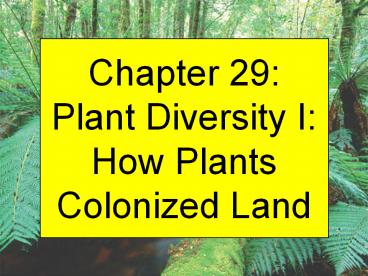Chapter 29: Plant Diversity I: How Plants Colonized Land - PowerPoint PPT Presentation
1 / 45
Title:
Chapter 29: Plant Diversity I: How Plants Colonized Land
Description:
Chapter 29: Plant Diversity I: How Plants Colonized Land Overview of Plant Phylogeny More Detail Nonvascular Plants Vascular Plants Cellulose-Synthesis From Alga to ... – PowerPoint PPT presentation
Number of Views:606
Avg rating:3.0/5.0
Title: Chapter 29: Plant Diversity I: How Plants Colonized Land
1
Chapter 29Plant Diversity IHow
PlantsColonized Land
2
Overview of Plant Phylogeny
Chamber-contained seed
Chara, the outlier to the plant phylogeny, is a
green alga
Naked seed
3
More Detail
Dont worry about dates
4
Nonvascular Plants
Nonvascular plants also lack woody tissue, seeds,
flowers, and fruits
Note majority are mosses
5
Vascular Plants
Seedless plants also lack flowers and fruits
Not all seed plants have flowers and fruits
6
Cellulose-Synthesis
Similarities in peroxisomes, flagellated sperm,
and cell division also link charophyscean algae
with green plants.
These distinctly rose-shaped arrays of proteins
are found only in land plants and charophycean
algae, suggesting their close kinship. p. 574,
Campbell Reece (2005)
7
From Alga to Plants
8
Charaphycena Algae
9
Scenario for Algae to Plants
- The ancestor of all plants was a green alga
- Green algae have plant-like chloroplasts,
plant-like cell walls, and a plant-like energy
storage molecule (starch) etc. - The ancestor of plants probably was a green alga
that lived whole or partially in very shallow
water, perhaps susceptible to periodic drying up - Those algae that could continue to metabolize
despite not being completely covered with water
presumably possessed a selective
advantageincluding shading those algae
restricted to water - The first roots were stems (stipes) that
physically connected out-of-water portions of
algae with still-in-water portions - Water diffused through short stems to keep
above-water, actively photosynthesizing tissues
from desiccating
10
The Challenges of Land
- Algae
- Get minerals and water from surrounding water
- Have their bodies supported by surrounding water
- Their sperm and spores swim through the water
- Plants
- Get their Minerals and Water from soil
- Soil is subject to desiccation
- Soil also is opaque to sunlight
- Do not have their weight supported by surrounding
water - Do not have, or have less water for sperm and
spores to swim through - To survive on land, plant ancestors had to
address these challenges
11
Plant Innovations
- Waxy cuticles water proofing of plant body
- Stomata holes in waxy cuticle
- Sporophyte (alternation of generations)
increased productivity per fertilization (does
not exist in Charophycean algae) - Vascular tissue connects roots to leaves
- Woody tissue allows greater plant height
- Sporopollenin polymer which prevents zygotes
from drying out - Pollen non-motile sperm carrier also male
gametophyte - Seeds embryo packaged with a supply of
nutrients inside a protective coat. p. 579,
Campbell Reece (2005) - Flowers allows more efficient pollen transfer
- Fruit embryo protection and dissemination
12
Waxy Cuticle Water Proofing
Air is desiccating (unless humidity is 100)
13
Stomate Gas Exchange
14
Sporophytes, ? Dominance
Note Plants are heteromorphic
15
Vasculature (etc.)
Water and minerals are passed up the xylem,
ultimately to be transpired out of the plant
Sugar, amino acids, and other organic molecules
are passed down phloem to the stem and roots
16
Cellulose ? Cell Walls
The cellulose of cell walls is important for
supporting plant tissues against gravitys pull
17
Lignin ? Woody Tissue
Lignin is the polymer that gives woody plants
their woodiness
Vasculature allong with woody tissue allowed
plants to grow taller, so as to avoid being
shaded by other plants
18
Coal ? Anaerobic Decay
19
Chara No Sporophyte
Zygote
Essentially four spores per fertilization
(corresponding to the typically 4 meiotic
products)
20
Delaying Meiosis
21
Alternation of Generations
22
A of G, Simplified!
23
Defining Plant Derived Traits
Hence plants are described as embryophytes
24
Embryo Retention (Analogy)
Weve seen embryo retention before
But in plants the embryo is dependent on parent
for nutrients
25
Defining Plant Derived Traits
An apical meristem is the cell division that
takes place at the tips of stems and roots
26
Bryophytes
Bryophytes have flagellated sperm and disseminate
using spores (not pollen)
We will mostly concern ourselves with phylum
Bryophyta
27
Liverworts
Longer-lived (conspicuous) gametophyte
28
Hornworts
Longer-lived (conspicuous) gametophyte
29
Mosses
Longer-lived (conspicuous) gametophyte
30
Bryophyte Life Cycle
31
Mosses Life Cycle (in order L-R)
32
Seedless Vascular Plants
We will mostly concern ourselves with phylum
Pterophyta
33
Fern Sporophytes
Longer-lived and larger (conspicuous) sporophyte
34
Fern Sorus
35
Fern Sporangium
36
Sporangium Releasing Spores
37
Germinating Fern Spore
38
Fern Gametophytes
39
Fern Gametangia
40
Young Fern Sporophytes
41
Fern Life Cycle
42
Evolution of Leaves
43
Innovation Different Spore Types
Seen in most non-seed bearing plants
Seen mostly in seed bearing plants
44
When Ferns ruled the Earth!
Artists conception of a Carboniferous forest
based on fossil evidence. Most of the large trees
with straight trunks are lycophytes. The tree on
the left with feathery branches is a horsetail.
Tree ferns, not shown, here, were also abundant
in the coal forests of the Carboniferous. p.
574, Campbell Reece (2005)
45
The End































